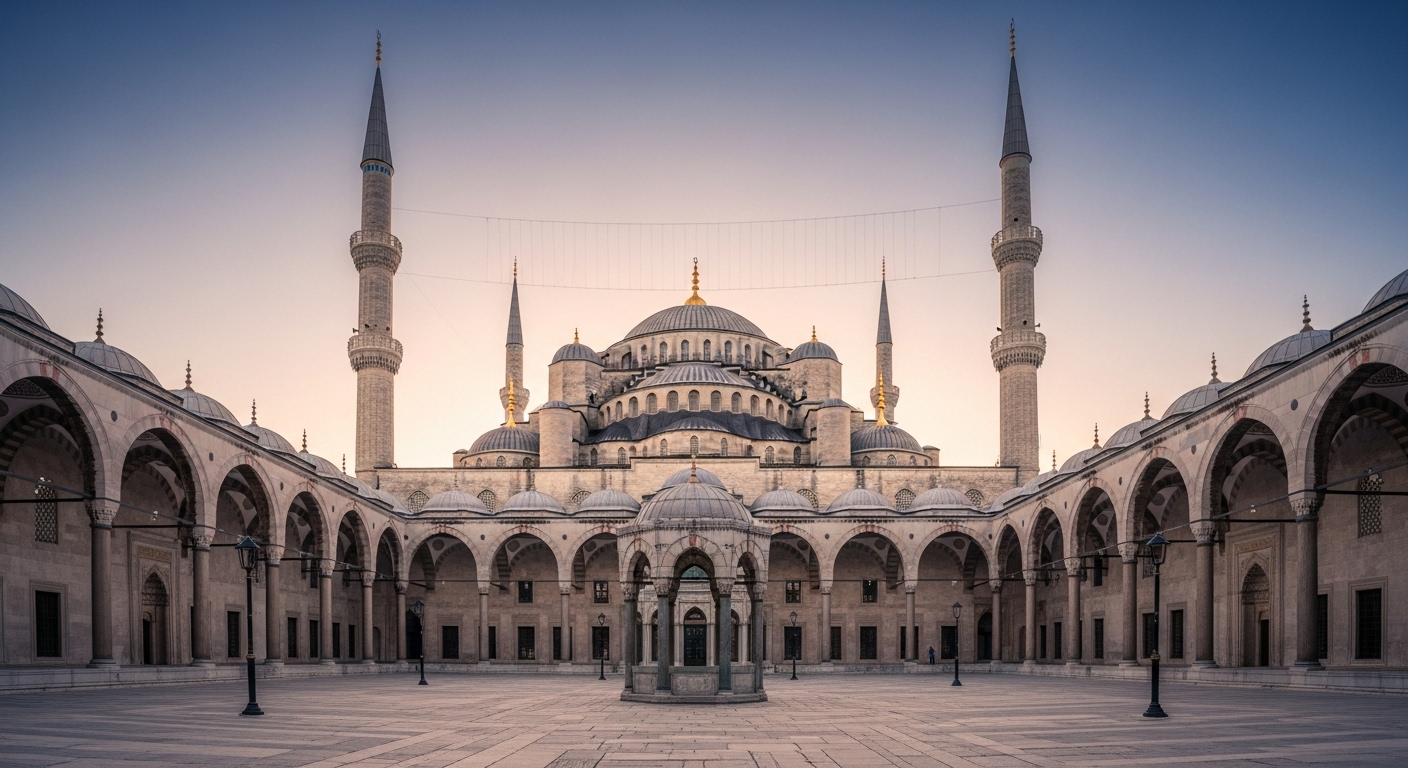Exploring the Blue Mosque (Sultanahmet Mosque): History, Architecture & Complete Visitor Guide
Discover the rich history, stunning architecture, visitor tips, photography advice, and nearby attractions of Istanbul’s iconic Blue Mosque (Sultanahmet Mosque) in this complete travel guide.

Introduction to the Blue Mosque
Nestled in the heart of Istanbul’s historic peninsula, the Sultanahmet Mosque—famously known as the Blue Mosque—is more than just an architectural masterpiece; it’s a living symbol of Turkey’s rich Islamic and Ottoman heritage. If you’ve ever dreamed of standing beneath soaring domes adorned with intricate blue Iznik tiles, hearing the soulful call to prayer echo across ancient courtyards, and witnessing centuries of devotion carved into marble and stone, the Blue Mosque is the place to be.
Why It’s Called the Blue Mosque
You might wonder: why do people call it the Blue Mosque? Well, step inside and you’ll have your answer instantly. The interior is decorated with more than 20,000 hand-painted blue tiles from Iznik (Nicaea), each meticulously crafted with floral motifs, geometric patterns, and Qur'anic inscriptions. When sunlight filters through its more than 200 stained-glass windows, these tiles cast a mesmerizing bluish hue, creating an ethereal glow that feels almost heavenly. Tourists and locals alike were so captivated by this blue ambiance that the nickname “Blue Mosque” stuck over centuries.
Significance in Istanbul’s Cultural Heritage
Beyond its dazzling tiles and grand architecture, the Blue Mosque holds immense cultural and spiritual value for Istanbul and for Muslims worldwide. It’s still an active place of worship—hosting thousands of worshippers daily—yet it graciously welcomes millions of visitors from all faiths. It stands as a bridge between past and present, blending Islamic devotion with the rich Byzantine legacy of its neighbor, the Hagia Sophia. This blend makes the Sultanahmet Square one of the most unique places on Earth where empires, cultures, and centuries converge.
History of Sultanahmet Mosque
The Vision of Sultan Ahmed I
The story begins in the early 17th century when Sultan Ahmed I, barely in his twenties, ascended the Ottoman throne. Unlike his predecessors, Ahmed I wanted to leave behind a legacy that rivaled the Hagia Sophia—then the greatest symbol of Byzantine glory. With the empire under pressure and previous wars draining the treasury, building such a grand mosque was a bold, perhaps controversial, ambition. Still, Sultan Ahmed I pressed on, seeing it as a testament to Ottoman power and piety.
Construction Timeline and Challenges
Construction started in 1609 under the renowned architect Sedefkar Mehmed Agha, a disciple of the legendary Mimar Sinan. Building the mosque was no small feat; it required an army of artisans, stonemasons, and tile makers working tirelessly for seven years. Challenges were plenty—from sourcing the finest marble to ensuring structural stability in an earthquake-prone city. Yet, by 1616, the mosque was completed, featuring six minarets—a feature that initially sparked controversy since it matched the number at Mecca’s Grand Mosque. To resolve this, an extra minaret was added to the one in Mecca.
Historical Events and Restoration Over Centuries
Over the centuries, the mosque weathered natural disasters, political upheavals, and the wear and tear of time. Major restorations occurred during the reign of Sultan Mahmud I and later in the 20th century under the Turkish Republic. Today, ongoing conservation efforts ensure that the mosque retains its glory while accommodating millions of visitors and worshippers. Every stone, dome, and tile tells a story—a testament to the resilience of this timeless icon.
Architectural Marvel of the Blue Mosque
The Iconic Domes and Minarets
When you first lay eyes on the Blue Mosque from Sultanahmet Square, it’s impossible not to feel awestruck. Its cascading domes and six slender minarets dominate Istanbul’s skyline like a crown jewel. The central dome, soaring 43 meters high and spanning 23.5 meters in diameter, is supported by four massive pillars known as “elephant feet.” This grand dome, flanked by a series of semi-domes, creates an impression of fluidity and harmony—a hallmark of classical Ottoman architecture.

Stunning Interiors and Iznik Tiles
Step inside, and the real magic unfolds. The vast prayer hall feels open yet intimate, illuminated by a constellation of hanging lamps and natural light streaming through stained glass. Every inch of wall and ceiling is adorned with floral and abstract patterns in blue, red, and gold hues. The mihrab (prayer niche) and minbar (pulpit) are carved from exquisite white marble, while calligraphic panels display verses from the Qur'an penned by the era’s greatest artists.
What makes the interior even more special is the craftsmanship of the Iznik tiles. These tiles, known for their rich cobalt blue and turquoise colors, were produced in workshops that once supplied palaces and mosques throughout the Ottoman Empire. Their beauty has endured centuries, a testament to the mastery of Ottoman ceramic art.
Symbolism in Ottoman Architecture
The mosque’s design isn’t just about beauty—it’s filled with symbolism. The six minarets symbolize the mosque’s status as an imperial mosque, signifying power and prestige. The harmonious blend of Byzantine church elements with classic Islamic design reflects the Ottomans’ ambition to fuse East and West, old and new. Everything, from the calligraphy to the symmetry, serves as a reminder of the divine order and the grandeur of God’s creation.
Visitor Guide to the Blue Mosque
Opening Hours and Best Visiting Times
If you're planning a visit to the Blue Mosque, timing is everything. The mosque is open daily, but because it’s an active place of worship, tourists are not allowed inside during the five daily prayer times, each lasting about 90 minutes. Generally, visiting hours for non-worshippers are from 8:30 AM to one hour before dusk, except during prayer breaks and on Friday mornings when the mosque is closed to tourists until 2:30 PM due to the special Friday prayer.
To avoid crowds and truly soak in the tranquil atmosphere, try visiting early in the morning right after opening or later in the afternoon. Midday often sees large tour groups, making it harder to appreciate the serenity and architectural details. Also, sunrise and sunset lend a magical golden hue to the exterior domes and minarets—perfect for photography enthusiasts.
Before you go, always check the official website or local notice boards because timings may change during Ramadan and other religious festivals. Being respectful of prayer times ensures that you contribute to the peaceful coexistence of worshippers and tourists—a unique feature of this living monument.
Entry Fees and What to Expect
Good news: visiting the Blue Mosque is absolutely free! Unlike some historic mosques that charge a small fee for maintenance, the Blue Mosque remains a place of prayer first and foremost, and welcoming visitors is seen as an act of hospitality.
However, donations are highly encouraged. There’s usually a donation box near the entrance—your contribution helps fund ongoing restoration and upkeep. Expect a short wait at the entrance, especially during peak tourist seasons like summer and spring. Security checks are minimal but bags may be screened.
Once inside, you’ll walk through a beautiful courtyard before entering the main prayer hall. You’ll be asked to remove your shoes and place them in a provided plastic bag, which you can carry with you. Lockers are usually not available, so keep an eye on your belongings.

Dress Code and Etiquette Tips
The Blue Mosque is not just a historical site—it’s a functioning mosque, so modest dress is a must. For women, a headscarf is required to cover hair. Shoulders and knees must be covered, and tight clothing is discouraged. If you didn’t bring a scarf or appropriate cover-up, don’t worry: free scarves and wraps are provided at the entrance, though returning them is appreciated.
Men should avoid wearing shorts and sleeveless tops. Long trousers and shirts are preferred. If you’re unsure, observe how locals dress and follow suit.
Inside, maintain a respectful silence. Photography is allowed, but avoid using flash, especially during prayers. Don’t step over people praying or disrupt worshippers for photos. It’s also polite to greet people softly and avoid loud conversations.
Lastly, remember to follow any signs or directions given by mosque staff—they’re there to help both visitors and worshippers enjoy this sacred space harmoniously.
Best Time to Visit the Blue Mosque
Seasonal Highlights and Crowd Levels
So, when is the best time to visit this architectural wonder? Istanbul is stunning year-round, but each season offers a different vibe at the Blue Mosque.
Spring (April to June): Arguably the best time! Pleasant weather, blooming tulips in Sultanahmet Square, and manageable crowds.
Summer (July to September): Warm and bustling with tourists. Expect longer lines and busier courtyards but enjoy longer daylight hours.
Autumn (October to November): Cooler temperatures and thinner crowds make for a peaceful experience.
Winter (December to March): Chilly, with fewer tourists. Snow-capped domes offer a fairy-tale-like photo opportunity, but be prepared for occasional rain or snow.
Friday prayers draw large local crowds, so visiting on other weekdays is generally smoother. Early mornings (right after opening) or late afternoons (an hour before closing) are the sweet spots for fewer crowds and soft, golden lighting—ideal for photography.
Tips for Early Morning and Evening Visits
Early risers are rewarded with a calm, almost mystical atmosphere. Birds fluttering around the minarets, the first rays of sun catching the domes—pure magic! Arriving early also means you might catch the imam’s melodious call to prayer without being rushed by crowds.
Evenings offer a different allure. As dusk approaches, the mosque lights up softly against the darkening sky, creating a stunning silhouette. The surrounding gardens are less crowded, giving you time to linger and take panoramic shots.
Whichever time you choose, plan at least an hour to fully explore the courtyard, admire the exterior, and spend time inside soaking up the details. If possible, combine your visit with a stop at nearby landmarks for a full Sultanahmet experience in one go.
Nearby Attractions in the Sultanahmet District
Hagia Sophia and Its Rich History
Just steps away from the Blue Mosque stands the majestic Hagia Sophia—arguably its only rival in beauty and historical significance. Originally built in 537 AD as a Byzantine cathedral, it later served as a mosque under the Ottomans and now operates as a mosque again, attracting millions of visitors yearly.
Inside Hagia Sophia, be prepared to marvel at an awe-inspiring fusion of Christian mosaics, Islamic calligraphy, and a massive dome that seems to float above you. Don’t miss the upper gallery for panoramic views and a close look at ancient mosaics. A visit to both the Blue Mosque and Hagia Sophia in one day will give you a deep appreciation for Istanbul’s layered history.
Topkapi Palace and the Ottoman Legacy
A short walk uphill brings you to Topkapi Palace, the opulent residence of Ottoman sultans for nearly 400 years. Explore lavish courtyards, treasure-filled rooms, and the famous Harem, where royal intrigue once unfolded behind gilded doors.
Allow at least two to three hours here—highlights include the Imperial Treasury, the Sacred Relics Room, and breathtaking views of the Bosphorus from the palace terraces. Buying tickets online in advance is wise, especially during peak tourist seasons.
Basilica Cistern: The Underground Wonder
Need a break from the sun or rain? Head to the Basilica Cistern, a few steps away from the Blue Mosque. This ancient underground reservoir, supported by 336 marble columns, once supplied water to the Great Palace and Topkapi Palace.
Dimly lit and eerily beautiful, it’s like stepping into an underground cathedral. Look for the mysterious Medusa head columns tucked away in a corner—one of Istanbul’s most intriguing photo spots.
Photography Tips for the Blue Mosque
Capturing the Exterior Beauty
The Blue Mosque is a dream come true for photographers. Its grand domes and slender minarets stand tall against the ever-changing Istanbul sky, offering countless angles and moods throughout the day. The best wide-angle shots are taken from Sultanahmet Square, where you can capture the mosque framed by the landscaped gardens and historical fountains.
If you want a postcard-perfect shot, arrive just after sunrise when the soft morning light bathes the stone in warm tones, and crowds are almost nonexistent. Another fantastic angle is from the Hippodrome side, where the mosque's impressive minarets appear layered behind each other. Don’t shy away from cloudy days either—dramatic skies can add mood and texture to your shots.
Experiment with different focal lengths. A wide lens is great for capturing the entire structure, while a zoom lens helps pick out details like intricate calligraphy and tile work from a distance. Drones are not permitted, so ground-based creativity is key!
Photographing Interiors Respectfully
Inside, the ambiance is sacred and serene, so be mindful when pulling out your camera. Photography is allowed, but no flash—flash can damage centuries-old tiles and disturb worshippers. A fast lens and steady hands will help in low light, as tripods are not allowed inside for security and safety reasons.
Try to visit during non-peak hours to capture the spacious prayer hall with fewer people. Focus on the blue tiles, stained-glass windows, chandeliers, and the exquisite mihrab. Respect people’s privacy; never photograph worshippers up close, especially during prayers.
Play with symmetry—Ottoman architecture is all about balance and geometric patterns, so center shots work beautifully here. Take your time to appreciate the craftsmanship through your lens; the details are endless.
Best Spots for Panoramic Shots
For an iconic panoramic shot, cross over to the Hagia Sophia side or stand at the entrance of the Sultanahmet Park. Here, you’ll capture both the Blue Mosque and the Hagia Sophia in one frame—two giants facing each other, embodying Istanbul’s unique blend of East and West.
Evening shots are equally rewarding. As the sun sets and lights illuminate the domes and minarets, the mosque turns into a magical silhouette against a deep blue sky. Use a higher ISO and wide aperture to handle the low light without losing clarity.
A final tip: don’t rush! Sit on a bench in the gardens, people-watch, and wait for that perfect shot when the mosque, sky, and atmosphere align. Sometimes, the best photos are unplanned moments you simply witness.
Practical Tips for Tourists
How to Get There
Getting to the Blue Mosque is straightforward, thanks to its prime location in the heart of Istanbul’s historic Sultanahmet district. If you’re staying anywhere near Sultanahmet, it’s a pleasant walk through cobblestone streets lined with cafes and shops.
For those coming from other parts of Istanbul, hop on the T1 tram line and get off at the Sultanahmet stop—it’s just a short stroll from there. Taxis and rideshares like BiTaksi are also convenient, but traffic can be unpredictable in this busy area, especially during weekends and holidays.
If you’re exploring multiple sights in the area—like Hagia Sophia, Topkapi Palace, and the Basilica Cistern—walking is your best bet. Everything is within a few minutes’ walk, and you’ll discover hidden courtyards and street vendors along the way.
Facilities and Accessibility
The Blue Mosque complex is quite visitor-friendly. Restrooms are available near the courtyard, and there are shoe racks and plastic bags at the entrance so you can carry your shoes during your visit.
While the main prayer hall is accessible, the marble courtyard has some uneven surfaces that can be tricky for wheelchairs or strollers. There are ramps and designated paths, but bringing assistance or a lightweight stroller can make your visit smoother if you’re traveling with young children or elderly family members.
Guides and audio tours are available in multiple languages, either at the mosque entrance or through local tour operators. A guided tour is worth it if you want deeper insights into the symbolism and stories behind the architecture and artwork.
Local Food and Souvenir Shops
After exploring the mosque, reward yourself with a taste of authentic Turkish cuisine at nearby restaurants and cafes. Grab a traditional simit (Turkish bagel) from street vendors, sip on fresh pomegranate juice, or sit down for a hearty kebab meal with Turkish tea.
Don’t forget to browse the local shops lining the streets near the mosque. You’ll find beautiful handmade ceramics, evil eye charms, silk scarves, and spices that make perfect souvenirs to remember your visit.
A word to the wise: always compare prices and don’t hesitate to haggle politely—bargaining is part of the shopping culture here and often leads to friendly conversations with local shopkeepers.
Conclusion
Standing tall for over 400 years, the Blue Mosque remains one of Istanbul’s most cherished symbols of beauty, faith, and Ottoman grandeur. From its awe-inspiring domes and mesmerizing blue tiles to its living role as a house of worship, it offers a window into a bygone era while staying alive in the present.
Whether you’re a history buff, architecture lover, spiritual seeker, or casual traveler, a visit to the Sultanahmet Mosque is bound to leave an imprint on your soul. So, plan your visit wisely, dress respectfully, linger under its arches, and soak in the atmosphere that has enchanted millions.
Don’t just see it—feel it, photograph it, and carry a piece of its magic with you long after you’ve left its sacred courtyard.
Have Question Or Suggestion ?
Please Share Your Thought, To Make It Real


